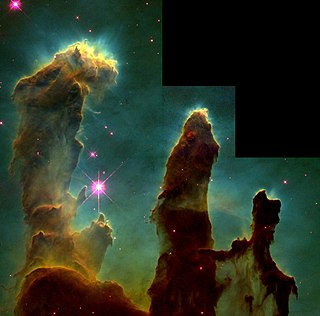 W
WA nebula is an interstellar cloud of dust, hydrogen, helium and other ionized gases. Originally, the term was used to describe any diffused astronomical object, including galaxies beyond the Milky Way. The Andromeda Galaxy, for instance, was once referred to as the Andromeda Nebula before the true nature of galaxies was confirmed in the early 20th century by Vesto Slipher, Edwin Hubble and others.
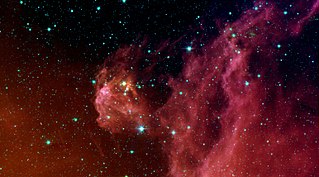 W
WBarnard 30 is a dark cloud in the Lambda Orionis ring, north of Lambda Orionis, also called Meissa. The region is about 1300 light years from Earth.
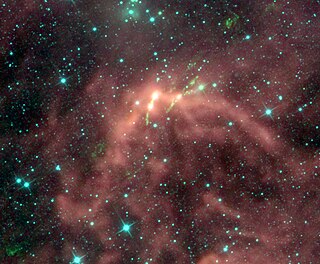 W
WThe dark nebula Barnard 203 or Lynds 1448 is located about one degree southwest of NGC 1333 in the Perseus molecular cloud, at a distance of about 800 light-years. Three infrared sources were observed in this region by IRAS, called IRS 1, IRS 2 and IRS 3.
 W
WA bipolar nebula is a type of nebula characterized by two lobes either side of a central star. About 10-20% of planetary nebulae are bipolar.
 W
WThe Boomerang Nebula is a protoplanetary nebula located 5,000 light-years away from Earth in the constellation Centaurus. It is also known as the Bow Tie Nebula and catalogued as LEDA 3074547. The nebula's temperature is measured at 1 K making it the coolest natural place currently known in the Universe.
 W
WA circumstellar disc is a torus, pancake or ring-shaped accumulation of matter composed of gas, dust, planetesimals, asteroids, or collision fragments in orbit around a star. Around the youngest stars, they are the reservoirs of material out of which planets may form. Around mature stars, they indicate that planetesimal formation has taken place, and around white dwarfs, they indicate that planetary material survived the whole of stellar evolution. Such a disc can manifest itself in various ways.
 W
WA dark nebula or absorption nebula is a type of interstellar cloud that is so dense that it obscures the visible wavelengths of light from objects behind it, such as background stars and emission or reflection nebulae. The extinction of the light is caused by interstellar dust grains located in the coldest, densest parts of molecular clouds. Clusters and large complexes of dark nebulae are associated with Giant Molecular Clouds. Isolated small dark nebulae are called Bok globules. Like other interstellar dust or material, things it obscures are only visible using radio waves in radio astronomy or infrared in infrared astronomy.
 W
WA deep-sky object (DSO) is any astronomical object that is not an individual star or Solar System object. The classification is used for the most part by amateur astronomers to denote visually observed faint naked eye and telescopic objects such as star clusters, nebulae and galaxies. This distinction is practical and technical, implying a variety of instruments and techniques appropriate to observation, and does not distinguish the nature of the object itself.
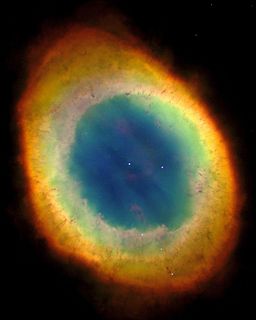 W
WAn emission nebula is a nebula formed of ionized gases that emit light of various wavelengths. The most common source of ionization is high-energy ultraviolet photons emitted from a nearby hot star. Among the several different types of emission nebulae are H II regions, in which star formation is taking place and young, massive stars are the source of the ionizing photons; and planetary nebulae, in which a dying star has thrown off its outer layers, with the exposed hot core then ionizing them.
 W
WAn evaporating gas globule or EGG is a region of hydrogen gas in outer space approximately 100 astronomical units in size, such that gases shaded by it are shielded from ionizing UV rays. Dense areas of gas shielded by an evaporating gas globule can be conducive to the birth of stars. Evaporating gas globules were first conclusively identified via photographs of the Pillars of Creation in the Eagle Nebula taken by the Hubble Space Telescope in 1995.
 W
WAn H II region or HII region is a region of interstellar atomic hydrogen that is ionized. It is typically a cloud of partially ionized gas in which star formation has recently taken place, with a size ranging from one to hundreds of light years, and density from a few to about a million particles per cubic cm. The Orion Nebula, now known to be an H II region, was observed in 1610 by Nicolas-Claude Fabri de Peiresc by telescope, the first such object discovered.
 W
WHD 87643 is a B[e] class binary star embedded in a reflection nebula.
 W
WHD 101584 is a suspected post-common envelope binary about 1800 to 5900 light-years distant in the constellation of Centaurus. The system is bright at optical wavelengths with an apparent visual magnitude of about 7. The primary is either a post-AGB star, but more likely a post-RGB star. The secondary is a red dwarf or possibly a low-luminosity white dwarf, which orbits the primary every 150-200 days. The system is surrounded by a slowly rotating circumbinary disk, probably with a face-on orientation towards the solar system and a size of about 150 astronomical units.
 W
WHerbig–Haro (HH) objects are bright patches of nebulosity associated with newborn stars. They are formed when narrow jets of partially ionised gas ejected by stars collide with nearby clouds of gas and dust at several hundred kilometres per second. Herbig–Haro objects are commonly found in star-forming regions, and several are often seen around a single star, aligned with its rotational axis. Most of them lie within about one parsec of the source, although some have been observed several parsecs away. HH objects are transient phenomena that last around a few tens of thousands of years. They can change visibly over timescales of a few years as they move rapidly away from their parent star into the gas clouds of interstellar space. Hubble Space Telescope observations have revealed the complex evolution of HH objects over the period of a few years, as parts of the nebula fade while others brighten as they collide with the clumpy material of the interstellar medium.
 W
WAn interstellar cloud is generally an accumulation of gas, plasma, and dust in our and other galaxies. Put differently, an interstellar cloud is a denser-than-average region of the interstellar medium, (ISM), the matter and radiation that exists in the space between the star systems in a galaxy. Depending on the density, size, and temperature of a given cloud, its hydrogen can be neutral, making an H I region; ionized, or plasma making it an H II region; or molecular, which are referred to simply as molecular clouds, or sometime dense clouds. Neutral and ionized clouds are sometimes also called diffuse clouds. An interstellar cloud is formed by the gas and dust particles from a red giant in its later life.
 W
WA molecular cloud, sometimes called a stellar nursery (if star formation is occurring within), is a type of interstellar cloud, the density and size of which permit the formation of molecules, most commonly molecular hydrogen (H2). This is in contrast to other areas of the interstellar medium that contain predominantly ionized gas.
 W
WNebulium was a proposed element found in astronomical observation of a nebula by William Huggins in 1864. The strong green emission lines of the Cat's Eye Nebula, discovered using spectroscopy, led to the postulation that an as yet unknown element was responsible for this emission. In 1927, Ira Sprague Bowen showed that the lines are emitted by doubly ionized oxygen (O2+), and no new element was necessary to explain them.
 W
WNGC 6309, also known as the Box Nebula, is a quadrupolar planetary nebula located in the constellation Ophiuchus. It is designated as PN in the galaxy morphological classification scheme and was discovered by the German astronomer Wilhelm Tempel in 1876. It has a luminosity of about 1800 times of the Sun.
 W
WNGC 6326 is a complex and irregularly structured planetary nebula located in the constellation Ara. It was discovered by Scottish astronomer James Dunlop on 26 August 1826. NGC 6326 is the result of the ejected material from the central binary star, which is nearing the end of its life. The blue and red color is due to the amount of radiation the star releases, thus causing the gasses to glow. NGC 6326 is located at about 11,000 light years away from Earth.
 W
WA protoplanetary nebula or preplanetary nebula (PPN) is an astronomical object which is at the short-lived episode during a star's rapid evolution between the late asymptotic giant branch (LAGB) phase and the subsequent planetary nebula (PN) phase. A PPN emits strongly in infrared radiation, and is a kind of reflection nebula. It is the second-from-the-last high-luminosity evolution phase in the life cycle of intermediate-mass stars.
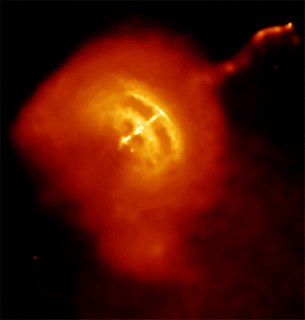 W
WA pulsar wind nebula, sometimes called a plerion, is a type of nebula sometimes found inside the shell of a supernova remnant (SNR), powered by winds generated by a central pulsar. These nebulae were proposed as a class in 1976 as enhancements at radio wavelengths inside supernova remnants. They have since been found to be infrared, optical, millimetre, X-ray and gamma ray sources.
 W
WIn astronomy, reflection nebulae are clouds of interstellar dust which might reflect the light of a nearby star or stars. The energy from the nearby stars is insufficient to ionize the gas of the nebula to create an emission nebula, but is enough to give sufficient scattering to make the dust visible. Thus, the frequency spectrum shown by reflection nebulae is similar to that of the illuminating stars. Among the microscopic particles responsible for the scattering are carbon compounds and compounds of other elements such as iron and nickel. The latter two are often aligned with the galactic magnetic field and cause the scattered light to be slightly polarized.
 W
WSh2-308, also designated as Sharpless 308, RCW 11, or LBN 1052, is an H II region located near the center of the constellation Canis Major, composed of ionised hydrogen. It is about 8 degrees south of Sirius, the brightest star in the night sky. The nebula is bubble-like, surrounding a Wolf–Rayet star named EZ Canis Majoris. This star is in the brief, pre-supernova phase of its stellar evolution. The nebula is about 4,530 light-years away from Earth, but some sources indicate that both the star and the nebula are up to 5,870 ly (1,800 pc) away. Yet others indicate the nebula is as close as 1,875 ly (575 pc) from Earth.
 W
WA supernova remnant (SNR) is the structure resulting from the explosion of a star in a supernova. The supernova remnant is bounded by an expanding shock wave, and consists of ejected material expanding from the explosion, and the interstellar material it sweeps up and shocks along the way.
 W
WVariable nebulae are reflection nebulae that change in brightness because of changes in their star.
 W
WA Wolf–Rayet nebula is a nebula which surrounds a Wolf–Rayet star.
 W
WThe Zanstra method is a method to determine the temperature of central stars of planetary nebulae. It was developed by Herman Zanstra in 1927.